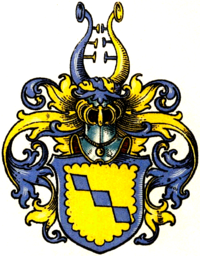Drolshagen (noble family)
Drolshagen was the name of an old Westphalian ministerial and knight family . It was named after the place Drolshagen in the Sauerland , but also had a branch in the Münsterland . There they found their way into the city nobility of the heirs .
history
A Arnoldus de Drolshagen appears in 1223 in a document issued in Soest , in the Count Gottfried II. Of Arnsberg the Marienfeld monastery sold goods. Probably the same as Arnoldus aduocatus (= Vogt) is a witness of a document from the Count, in which he transfers an estate to Claholt Monastery. In 1227 he was now referred to as Arnoldus aduocatus de Druylshagen , witness as Archbishop Heinrich I of Cologne , notarized a dispute between Count Heinrich von Sayn and Otto von Ravensberg over some goods. In 1232 he was referred to as Aduocatus eiusdem ecclesiae of the Church of St. Clemens in Drolshagen. In 1258, a Henricus aduocatus witnessed when Archbishop Konrad von Hochstaden transferred the mountain from the Grafschaft monastery to Siegfried von Wittgenstein and Adolf von Grafschaft, on which they later founded the city of Berleburg .
At times the von Drolshagen were also lords of the Waldenburg . The Waldenburg later fell to Johann von Plettenberg through marriage . The family had a stake in Hundem Free County for a while. A branch of the family settled in Munster ; 1362, II. 13th, inheritance of the brothers Henrich and Arnold von Drolshagen. Arnold receives all goods in the Münster monastery.
Several canons in Münster and Utrecht come from this family . An Everhard von Drolshagen was a cathedral sexton. An Adolf von Drolshagen was even provost at the old cathedral in Münster. He was also the teacher of the later Bishop Ludwig II of Hesse . A Bernd de Drolshagen was referred to as a knight in 1362. It is also possible that a mayor of Münster, Arnold Drolshagen, named by Johann Dietrich von Steinen , is a member of the family.
Around 1470, an Arndt von Drolshagen wrote a kind of family story, mainly about the Münsterland branch.
The family existed until the early modern period . A Heinrich von Drolshagen was a monk in Corvey in 1678 . In 1554 a Jurgen von Drolshagen belonged to the hereditary men in Münster . In 1579 Lütkenbeck belonged to the Münster family branch. Around 1590 they also owned the Rorup manor . Apparently there was a close relationship with the St. Aegidii Monastery . A Christina von Drolshagen died there in 1495. An Anna von Drolshagen was a nun there in the 18th century. Numerous members of the family are also named as benefactors of the facility. Their role was just as important for the Niesing monastery . Elisabeth von Drolshagen was elected mother of the house in 1500. Ida Maria von Drolshagen was a choir sister in the Herzebrock monastery and died in 1736.
There was also a Livonian family with the same name. This is said to come from Westphalia, but was probably not related to this sex.
coat of arms
The coat of arms shows three blue (silver) awakenings (diamonds) descending diagonally to the right in gold within a blue wavy border . On the helmet with blue-gold covers on the right a blue and on the left a gold buffalo horn, each with three nails in mixed up colors on the inside .
Individual evidence
- ↑ Archive Plettenberg -Hovestadt- certificate 80th
- ↑ Hömberg, Book IX, page 93.
- ^ Wilhelm Kohl: The dioceses of the ecclesiastical province of Cologne. The diocese of Münster. 4, The Cathedral Monastery of St. Paul in Münster. Berlin, 1982 p. 462, p. 503
- ^ Rudolf Wendt zu Crassenstein: Message about the family von Drolshagen from the knight Arndt von Drolshagen 1470. In: Journal for patriotic history and antiquity. Vol. 17 Münster, 1856 digitized
- ^ Wilhelm Kohl: The Diocese of Munster 10. The Cistercian, later Benedictine convent St. Aegidii in Munster. Berlin, 2009
- ^ Wilhelm Kohl: The dioceses of the ecclesiastical province of Cologne. The diocese of Münster I. The sister houses according to the Augustinian rule. (Germania Sacra NF 3) Berlin, 1968 p. 186
- ^ Edeltraud Klueting: The Kanonissenstift and Benedictine convent Herzebrock. (Germania Sacra NF 21) Berlin, 1986 p. 265
- ^ Yearbook for Genealogy, Heraldry and Sphragistics , Mitau, 1899 p. 82
- ↑ State Archives Münster
literature
- Ernst Heinrich Kneschke: New general German nobility lexicon. Vol. 2 Leipzig 1860, p. 583
Web links
- Pickert Collection of Sauerland noble families (PDF; 778 kB)
